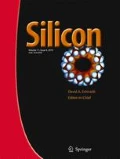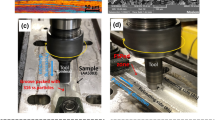Abstract
In the present investigation, Al-SiC functionally graded materials (FGM) were produced via. Friction stir processing (FSP) through a novel approach. The new approach involved a mathematical model for positioning holes in such a manner that the composition of the reinforcement (SiC) varied from maximum to minimum over a given length. Two tools with different pin profiles: conventional tool (CON) and hybrid tool (HYB), were employed for the process. The CON tool consisted of threads with zero flats while the HYB tool was a combination of threaded part and square (four flats) cross-section. The impact of pin profiles on the dispersion of SiC particles in the stir zone (SZ) of the processed specimens was studied and it was found be to more effective with HYB tool. This was because of the pulsating action induced by the flat edges and flow of material in downward direction. The HYB tool showed a 6.03% improvement in tensile strength vis-à-vis the sample processed by the CON tool as evidenced by mechanical properties and validated by electron backscatter diffraction analysis. The sizes of the grain in SZ for CON and HYB tools were 4.8 μm and 2.7 μm respectively and a huge fraction of high angle boundaries was observed in the HYB tool when compared to CON tool. The corrosion and wear resistance of FG samples also improved with the addition of SiC particles. The study brings out features of the mechanism of the process responsible for improved mechanical properties of functionally graded (FG) samples attained using HYB tool.
Similar content being viewed by others
Data Availability
Not applicable
References
Saleh B, Jiang J, Fathi R, al-hababi T, Xu Q, Wang L, Song D, Ma A (2020) 30 years of functionally graded materials: an overview of manufacturing methods, applications and future challenges. Compos. B. Eng. 201:108376. https://doi.org/10.1016/j.compositesb.2020.108376
Mi N, Shirvanimoghaddam K (2016) Functionally graded materials: a review of fabrication and properties. Appl. Mater. Today 5:223–245. https://doi.org/10.1016/j.apmt.2016.10.001
Gayen D, Tiwari R, Chakraborty D (2019) Static and dynamic analyses of cracked functionally graded structural components: a review. Compos. B. Eng. 173:106982. https://doi.org/10.1016/j.compositesb.2019.106982
El-Galy IM, Saleh BI, Ahmed MH (2019) Functionally graded materials classifications and development trends from industrial point of view. SN Appl. Sci. 1:1–23. https://doi.org/10.1007/s42452-019-1413-4
Jha DK, Kant T, Singh RK (2013) A critical review of recent research on functionally graded plates. Compos. Struct. 96:833–849. https://doi.org/10.1016/j.compstruct.2012.09.001
Saleh BI, Ahmed MH (2019) Development of functionally graded tubes based on pure Al/Al2O3 metal matrix composites manufactured by centrifugal casting for automotive applications. Met. Mater. Int. 26:1430–1440. https://doi.org/10.1007/s12540-019-00391-3
Ghadami F, Sabour Rouh Aghdam A, Ghadami S (2020) Preparation, characterization and oxidation behavior of CeO2-gradient NiCrAlY coatings applied by HVOF thermal spraying process. Ceram. Int. 46:20500–20509. https://doi.org/10.1016/j.ceramint.2020.05.155
Saleh B, Jiang J, Ma A, Song D, Yang D (2019) Effect of Main parameters on the mechanical and Wear behaviour of functionally graded materials by centrifugal casting: a review. Met. Mater. Int. 25:1395–1409. https://doi.org/10.1007/s12540-019-00273-8
Zhang X, Guo L, Yang F, Volinsky AA, Hostetter M, Guo Z (2019) 3D gel printing of graded TiC-high manganese steel cermet. J. Mater. Sci. 54:2122–2132. https://doi.org/10.1007/s10853-018-2945-5
Surya MS, Prasanthi G (2021) Effect of silicon carbide weight percentage and number of layers on microstructural and mechanical properties of Al7075/SiC functionally graded material. Silicon. https://doi.org/10.1007/s12633-020-00865-9
Zhou H, Wang Z, Wang B (2020) Fabrication of WC-co/(Ti, W)C graded cemented carbide by spark plasma sintering. Int. J. Refract. Met. Hard Mater. 87:105141. https://doi.org/10.1016/j.ijrmhm.2019.105141
Zhang C, Chen F, Huang Z, Jia M, Chen G, Ye Y, Lin Y, Liu W, Chen B, Shen Q, Zhang L, Lavernia EJ (2019) Additive manufacturing of functionally graded materials: a review. Mater. Sci. Eng. A 764:138209. https://doi.org/10.1016/j.msea.2019.138209
Rathee S, Maheshwari S, Siddiquee AN (2018) Issues and strategies in composite fabrication via friction stir processing : a review. Mater. Manuf. Process. 33:239–261. https://doi.org/10.1080/10426914.2017.1303162
Vasić B, Ralević U, Cvetanović Zobenica K, M. Smiljanić M, Gajić R, Spasenović M, Vollebregt S (2020) Low-friction, wear-resistant, and electrically homogeneous multilayer graphene grown by chemical vapor deposition on molybdenum. Appl. Surf. Sci. 509:144792. https://doi.org/10.1016/j.apsusc.2019.144792
Contatori C, Domingues NI, Barreto RL et al (2020) Effect of mg and cu on microstructure, hardness and wear on functionally graded Al–19Si alloy prepared by centrifugal casting. J. Mater. Res. Technol. 9:15862–15873. https://doi.org/10.1016/j.jmrt.2020.11.050
Amherd Hidalgo A, Frykholm R, Ebel T, Pyczak F (2017) Powder metallurgy strategies to improve properties and processing of titanium alloys: a review. Adv. Eng. Mater. 19:1–14. https://doi.org/10.1002/adem.201600743
Loh GH, Pei E, Harrison D, Monzón MD (2018) An overview of functionally graded additive manufacturing. Addit. Manuf. 23:34–44. https://doi.org/10.1016/j.addma.2018.06.023
Khodabakhshi F, Gerlich AP (2018) Potentials and strategies of solid-state additive friction-stir manufacturing technology: a critical review. J. Manuf. Process. 36:77–92. https://doi.org/10.1016/j.jmapro.2018.09.030
Weglowski MS (2018) Friction stir processing – state of the art. Arch. Civ. Mech. Eng. 18:114–129. https://doi.org/10.1016/j.acme.2017.06.002
Wang W, Han P, Peng P, Zhang T, Liu Q, Yuan SN, Huang LY, Yu HL, Qiao K, Wang KS (2020) Friction stir processing of magnesium alloys: a review. Acta Metall. Sin. (Engl. Lett.) 33:43–57. https://doi.org/10.1007/s40195-019-00971-7
Rathee S, Maheshwari S, Siddiquee AN, Srivastava M (2018) A review of recent Progress in solid state fabrication of composites and functionally graded systems via friction stir processing. Crit. Rev. Solid State Mater. Sci. 43:334–366. https://doi.org/10.1080/10408436.2017.1358146
Gandra J, Mirandaa R, Vilaca P et al (2011) Functionally graded materials produced by friction stir processing. J. Mater. Process. Technol. 211:1659–1668
Mishra RS, Ma ZY, Charit I (2003) Friction stir processing : a novel technique for fabrication of surface composite. Mater. Sci. Eng. A 341:1–4
Miranda RM, Santos TG, Gandra J, Lopes N, Silva RJC (2013) Reinforcement strategies for producing functionally graded materials by friction stir processing in aluminium alloys. J. Mater. Process. Technol. 213:1609–1615. https://doi.org/10.1016/j.jmatprotec.2013.03.022
Saadatmand M, Mohandesi JA (2014) Comparison between wear resistance of functionally graded and homogenous Al-SiC nanocomposite produced by friction stir processing (FSP). J. Mater. Eng. Perform. 23:736–742. https://doi.org/10.1007/s11665-013-0839-x
Bikkina V, Talasila SR, Adepu K (2020) Characterization of aluminum based functionally graded composites developed via friction stir processing. Trans. Nonferrous Met. Soc. China (Engl. Ed.) 30:1743–1755. https://doi.org/10.1016/S1003-6326(20)65335-3
Zheng K, Politis DJ, Wang L, Lin J (2018) A review on forming techniques for manufacturing lightweight complex—shaped aluminium panel components. Int. J. Light Mater. Manuf. 1:55–80. https://doi.org/10.1016/j.ijlmm.2018.03.006
Cui Y, Wang L, Ren J (2008) Multi-functional SiC/Al composites for aerospace applications. Chin. J. Aeronaut. 21:578–584. https://doi.org/10.1016/S1000-9361(08)60177-6
Verma, S., Gupta, M., Misra, J.P.: Friction stir welding of aerospace materials: a state of art review. DAAAM Int Sci B 135–150 (2016). https://doi.org/10.2507/daaam.scibook.2016.13
Elangovan K, Balasubramanian V (2008) Influences of tool pin profile and tool shoulder diameter on the formation of friction stir processing zone in AA6061 aluminium alloy. Mater. Des. 29:362–373. https://doi.org/10.1016/j.matdes.2007.01.030
Reza-E-Rabby M, Tang W, Reynolds AP (2018) Effects of thread interruptions on tool pins in friction stir welding of AA6061. Sci. Technol. Weld. Join. 23:114–124. https://doi.org/10.1080/13621718.2017.1341363
Singh CV, Pachauri P, Dwivedi SP, Sharma S, Singari RM (2019) Formation of functionally graded hybrid composite materials with Al2O3 and RHA reinforcements using friction stir process. Aust. J. Mech. Eng. 00:1–14. https://doi.org/10.1080/14484846.2019.1679583
Moradi MM, Jamshidi Aval H, Jamaati R (2019) Effect of tool pin geometry and weld pass number on microstructural, natural aging and mechanical behaviour of SiC-incorporated dissimilar friction-stir-welded aluminium alloys. Sadhana – Acad. Proc. Eng. Sci. 44:1–9. https://doi.org/10.1007/s12046-018-0997-5
Khodabakhshi F, Gerlich AP, Švec P (2017) Fabrication of a high strength ultra-fine grained Al-mg-SiC nanocomposite by multi-step friction-stir processing. Mater. Sci. Eng. A 698:313–325. https://doi.org/10.1016/j.msea.2017.05.065
Kumar A, Raju LS (2012) Influence of tool pin profiles on friction stir welding of copper. Mater. Manuf. Process. 27:1414–1418. https://doi.org/10.1080/10426914.2012.689455
Hosseini SA, Ranjbar K, Dehmolaei R, Amirani AR (2015) Fabrication of Al5083 surface composites reinforced by CNTs and cerium oxide nano particles via friction stir processing. J. Alloys Compd. 622:725–733. https://doi.org/10.1016/j.jallcom.2014.10.158
Devaraju A, Kumar A, Kotiveerachari B (2013) Influence of addition of grp/Al2O3p with SiCp on wear properties of aluminum alloy 6061-T6 hybrid composites via friction stir processing. Trans. Nonferrous Met. Soc. China (Engl. Ed.) 23:1275–1280. https://doi.org/10.1016/S1003-6326(13)62593-5
McNelley TR, Swaminathan S, Su JQ (2008) Recrystallization mechanisms during friction stir welding/processing of aluminum alloys. Scr. Mater. 58:349–354. https://doi.org/10.1016/j.scriptamat.2007.09.064
Archard JF (1953) Contact and rubbing of flat surfaces. J. Appl. Phys. 24:981–988. https://doi.org/10.1063/1.1721448
Peng J, Zhang Z, Huang J et al (2019) The effect of the inhomogeneous microstructure and texture on the mechanical properties of AZ31 mg alloys processed by friction stir processing. J. Alloys Compd. 792:16–24. https://doi.org/10.1016/j.jallcom.2019.04.014
Calderón JA, Henao JE, Gómez MA (2014) Erosion-corrosion resistance of Ni composite coatings with embedded SiC nanoparticles. Electrochim. Acta 124:190–198. https://doi.org/10.1016/j.electacta.2013.08.185
Almomani MA, Tyfour WR, Nemrat MH (2016) Effect of silicon carbide addition on the corrosion behavior of powder metallurgy cu-30Zn brass in a 3.5 wt% NaCl solution. J. Alloys Compd. 679:104–114. https://doi.org/10.1016/j.jallcom.2016.04.006
Baradarani F, Mostafapour A, Shalvandi M (2020) Enhanced corrosion behavior and mechanical properties of AZ91 magnesium alloy developed by ultrasonic-assisted friction stir processing. Mater. Corros. 71:109–117. https://doi.org/10.1002/maco.201911084
Vijayavel P, Balasubramanian V (2017) Effect of pin profile volume ratio on microstructure and tensile properties of friction stir processed aluminum based metal matrix composites. J. Alloys Compd. 729:828–842. https://doi.org/10.1016/j.jallcom.2017.09.117
Acknowledgements
The authors thank the Centre for Automation and Instrumentation (CAI), NIT Warangal for providing necessary computational facilities to carry out the work. The authors also thank Prof. Indraveer Samjdar, Incharge of OIM texture lab, IIT Bombay for providing them with EBSD facility. The first author acknowledges MHRD research fellowship from NIT Warangal.
Code Availability
Not applicable
Funding
The author(s) received no financial support for the research, authorship, and/or publication of this article. This research received no specific grant from any funding agency in the public, commercial, or not-for-profit sectors.
Author information
Authors and Affiliations
Contributions
Venkatesh Bikkina: Investigation; Writing-Editing original draft; Sadasiva Rao Talasila: Reviewing original draft; Kumar Adepu: Conceptualization.
Corresponding author
Ethics declarations
The authors declare that they have no known competing financial interests or personal relationships that could have appeared to influence the work reported in this paper.
Ethics Approval
Not applicable
Consent to Participate
Not applicable
Consent for Publication
Not applicable as the manuscript does not contain any data from individual.
Research Involving Human Participants and/or Animals
Not applicable
Conflict of Interest/ Competing Interests
The authors declare that they have no conflicts of interest reported in this paper
Additional information
Publisher’s Note
Springer Nature remains neutral with regard to jurisdictional claims in published maps and institutional affiliations.
Supplementary Information
ESM 1
(PDF 46 kb)
Rights and permissions
About this article
Cite this article
Bikkina, V., Talasila, S.R. & Adepu, K. Improvement of Mechanical and Corrosion Properties of Al/SiC Functionally Graded Material Using a Novel Hybrid Tool in Friction Stir Processing. Silicon 14, 6123–6139 (2022). https://doi.org/10.1007/s12633-021-01380-1
Received:
Accepted:
Published:
Issue Date:
DOI: https://doi.org/10.1007/s12633-021-01380-1




